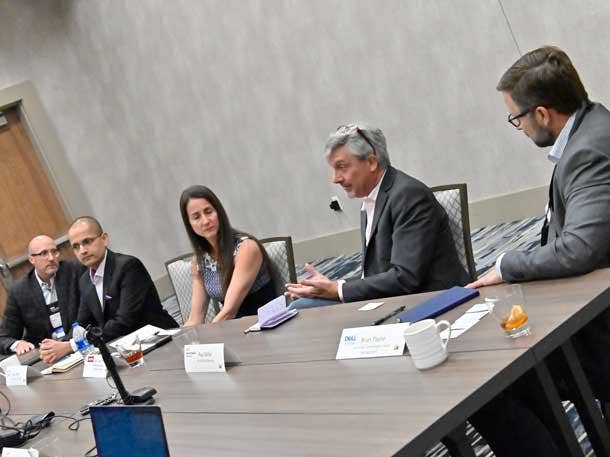IT-As-A-Service Model Marks Channel Maturity, Tech Execs Say
“More and more, the first part of our conversations with customers is 'how do you want to acquire?' versus 'what do you want to acquire?' Not every partner has the maturity to transition to this model, but we feel that our position in managed services is helping us expand into the consumption model,” says Kent MacDonald of solution provider Long View Systems.

Some of the largest technology vendors in the world are shifting toward the IT-as-a-Service trend. Cisco, Dell Technologies, Lenovo, and Hewlett Packard Enterprise (HPE), to name a few, are offering consumption-based IT services. For partners, selling IT as a service is a sign of channel maturity, tech executives said.
That's because "partnering" with customers to understand what their pain points and what they expect from their IT environments, rather than selling a product once and returning in three years for the refresh, is the new partner model and what customers are looking for in a solution provider, said Laura Latrello, vice president and general manager for Lenovo's Data Center Services business, at a recent CRN roundtable session.
"[Customers] are going to expect [partners] to be flexible and agile, upgrade their equipment when they need it, add more VMs when they need it, and you want to have that partnership with them so that you understand their entire journey and what's happening every day in their infrastructure," she said. "It's no longer about meeting with them for an upfront purchase and RFP and then washing your hands."
[Related: As-A-Service Model Creates ‘Additional Risk’ For Channel Partners]
Lenovo today is offering TruScale Infrastructure Services, which allows customers to use and pay for on-premises data center hardware and services without having to purchase the equipment. Latrello said that customers, bogged down by "too much choice" and too little time, are more and more demanding a consumption-based, as a service model to make their IT teams more efficient in how they spend their time.
Long View Systems, a Canadian solution provider, has built a culture around selling managed IT and cloud services, including managed security, backup, Infrastructure as a Service (IaaS) and private cloud solutions to its base of customers in the energy, transportation, and financial verticals.
"We see a space in the market for us to be differentiated by blending our managed services with IT services and we are persistently lobbying our partners, like Cisco, to continue to expand it’s as a service, recurring revenue model," said Kent MacDonald, senior vice president of Strategic Alliances for Long View Systems.
Some vendors are ahead of others when it comes to acceptability of consumption-based IT buying and selling from its partners, MacDonald said. Long View has seen a decline in customers buying in a capex model and more are favoring a consumption-based model, which allows Long View to wrap its own services around the deal, he said.
"More and more, the first part of our conversations with customers is 'how do you want to acquire?' versus 'what do you want to acquire?'" MacDonald said. "Not every partner has the maturity to transition to this model, but we feel that our position in managed services is helping us expand into the consumption model and it’s complimentary to the journey we’ve been on for 15 years.”
Channel partners that aren’t on-board with the consumption-based IT model are going to miss this wave, said Paul Miller, HPE’s vice president of global marketing, software-defined and cloud group.
“The as a product market, it's flat to down over the next three to four or five years. And all of the growth is As a Service,” Miller said.
HPE is no stranger to the IT-as-a-Service model. Today, the tech giant is offering HPE GreenLake through its channel partners. HPE gives customers a self-service portal and allows them to pay for only what they use. At the same time, their IT environment is managed for them.
“It's where the market is going and it’s what customers want,” Miller said. “But when you think about it, it's not a traditional managed services approach because [partners] aren’t going to win this game of managing our mess for less. It's about modernization to a true end-to-end service model.”
Katalyst, a Charlotte, N.C.-based solution provider, offers data center, security, and networking managed services. Katalyst's customers are leaning on the company for its operational expertise, said Jesse White, field CTO for the solution provider.
Katalyst will at times offload IT "chores" to other partners so it can focus on its "core" competencies for its customers. "You can very quickly dilute your value if you try to do everything," he said.
White said that to further the channel's success with the IT as a service model, vendors need to allow partners to roll what once would be a capex purchase into an annuity model, which many of Katalyst's vendor partners, including Cisco, HPE, and VMware, are starting to do today. "This will allow our customers to consume IT at a very bite-sized rate," he said.
At the same time, vendors also need to continue to shift their focus from products to being a services-led company, White said. "There’s some really great products, but customers really need scale, flexibility, certainty, and making sure their apps are going to be delivered."
Selling IT in a consumption-based model helps partners stay involved with their customers through the entire lifecycle, which in turn, helps partners develop better solutions and grow their spend with customers, said Nirav Sheth, vice president of Partner Solutions, Architecture and Engineering for Cisco.
“To really be successful throughout that lifecycle, [partners] need to really understand what the outcomes are and what are the business process workflows and how that technology is going to be integrated,” Sheth said. “When you backed it up with the right level of enablement and the right incentives … it's kind of a virtuous cycle that everybody wins. And fundamentally it starts with making sure the customer's winning.”